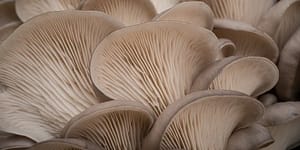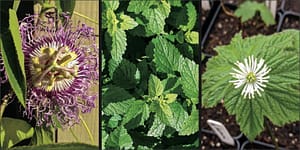9 Simple Steps to Sheet Mulching: Turn Barren Soil into Black Gold

To turn a barren lot into a permaculture paradise, you’ve got to start from the ground up — and sheet mulching is an easy way to start. Here are some tips to help you strengthen your soil with the power of sheet mulching!
The following is an excerpt is from Perennial Vegetables by Eric Toensmeier. It has been adapted for the web.
(Cross section of a newly sheet-mulched garden bed showing layers of material. Illustration by Elayne Sears.)
What Is Sheet Mulching?
Sheet mulching combines soil improvement, weed removal, and long-term mulching in one fell swoop. This technique, also known as lasagna gardening, can build remarkable soils in just a few years.
There are several key components. First, a weed barrier like cardboard is laid down to smother weeds.
In theory (and quite often in practice) the cardboard decomposes after the weeds have all died and turned into compost.
The second ingredient is to add compost, or build a layered compost pile that will enrich your new garden bed.
The third step is to add a thick layer of mulch on top, to keep new weeds from getting established.
9 Simple Steps to Sheet Mulching
I have had great results with sheet mulching, although sometimes the first year is a bit rough on delicate species, until the raw materials break down.
You can use sheet mulching to turn lawns or weedy waste areas into gardens in just a few hours, or even to build soil from scratch inside built frames for raised beds.
Sheet mulch can range from just a few inches thick to 2 feet or more, depending on how bad your soil is and how much raw material you have available (it will cook down and settle quite a bit).
1. Mowing and Cutting
Mow or cut your lawn, weeds, or other vegetation right down to the ground.
2. Early Planting
Plant any crops that will require a large planting hole (including woody plants, perennials in large pots, and large transplants).
3. Soil Amendments
Add soil amendments (as determined by your soil test).
4. Water, Water, Water
Water the whole area thoroughly.
You are going to be putting a layer of cardboard or newspaper over it, and rain and irrigation won’t soak through very well until that weed barrier breaks down. Water also helps the decomposition process get going.
5. Spread Compost
If you have compost materials that may contain weed seeds (like fresh manure, leaves, or hay), spread them in layers on the ground.

Addition of rotted leaves below thick paper bags as a weed barrier with a layer of compost and mulch on top—just a few hours of work.
Put a dry, carbonaceous layer of hay or shredded leaves below any manure layer.
Avoid thick layers, and make sure to get a good carbon-to-nitrogen ratio just as if you were building a compost pile. Water this layer well.
6. Weed Barrier
Lay down a weed barrier.
I prefer to use large sheets of cardboard from appliance stores, because these last longer and are quicker to lie down.
You can use layers of wet newspaper too.
Make sure to have a 4- to 6-inch overlap where sheets meet so buried weeds can’t find a route to the surface.
If you have already planted crops, or have other preexisting plants, don’t mulch over them.
Cut holes in the cardboard to make some breathing space for each plant (or leave some room around each plant when laying newspaper).
7. Add Organic Materials
Now you can add your weed-free organic materials. I like to keep it simple, and just add a nice layer of compost.
You can also do some sheet composting here, alternating layers of nitrogen-rich materials like fresh grass clippings with carbonaceous materials like weed-free straw.
8. Add Your Top Layer
Now you add your final top mulch layer, at least 3 inches thick.
Water the whole bed thoroughly once again. Your sheet mulch bed is complete.
9. Get to Planting!
You can plant right into your bed if you like. To plant tubers or potted plants, just pull back the top layers until you get to the weed barrier.
Cut an X in the cardboard or newspaper. If you are transplanting a large plant, peel back the corners of the X.
Throw a double handful of compost in the planting hole and then put in the plant.
Pull the layers and top mulch back around the plant, water well, and you’re all set.
Planting seeds is easy too. Just pull back the top mulch to the compost layer and plant your seeds.
You may want to cut through the weed barrier below first, depending on weed pressure below the barrier. If you are planting seeds, be sure to water regularly, as compost on top of cardboard can dry out quickly.
Simplicity of Sheet Mulching
Sheet mulch can be as simple as three layers: cardboard, compost, and straw. But compost isn’t cheap, and it can be fun and thrifty to add layers of organic materials that will break down to make compost on their own.
When doing so, you want to alternate layers of high-nitrogen material (greens) with high-carbon material (browns), just like the recipe you use to build an ordinary compost pile.
You want to have more carbon materials than nitrogen: the ideal ratio by weight is 30:1 carbon to nitrogen, which translates roughly to two to three times as much carbon bulk as nitrogen.
Keep these layers thin (3 inches at most) and they will break down more quickly. Some items should be shredded first—leaves because they mat, and large items like cornstalks so they break down more quickly.
Remember also that some materials must be kept below the root barrier because they may contain viable seeds.
Recommended Reads
Recent Articles
What’s so great about oyster mushrooms? First, you can add them to the list of foods that can be grown indoors! They are tasty, easy to grow, multiply fast, and they love a variety of substrates, making oyster mushrooms the premium choice. The following is an excerpt from Fresh Food from Small Spaces by R. J.…
Read MoreEver heard the phrase, “always follow your nose?” As it turns out, this is a good rule of thumb when it comes to chicken manure. Composting chicken manure in deep litter helps build better chicken health, reduce labor, and retain most of the nutrients for your garden. The following is an excerpt from The Small-Scale Poultry…
Read MoreIn her book, The Art of Science and Grazing, nationally known grazing consultant Sarah Flack identifies the key principles and practices necessary for farmers to design, and manage, successful grazing systems. This book is an essential guide for ruminant farmers who want to crate grazing systems that meet the needs of their livestock, pasture plants,…
Read MoreWant to start your own medicinal herb garden? Passionflower, lemon balm, and goldenseal are great places to begin! These herbs are jam-packed with medicinal properties and easy to grow in a majority of climates.
Read MoreThis long-lived perennial legume is used for forage and erosion control. Kudzu is edible with many medicinal uses and other applications. Pollinators of all kinds love its prodigious lavender blooms!
Read More









